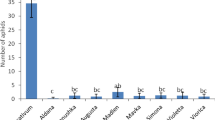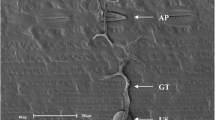Abstract
Despite the important yield loss caused by Macrosiphum euphorbiae on potato crops, little is known about its direct effect on Solanum tuberosum plant. These phloemophagous insects use their piercing mouthparts (stylets) to follow intercellular pathway till reaching phloem sap. Consequently, host cells are punctured and aphid saliva is injected periodically to seal off the pores. Thus, host tissues are challenged by both mechanical wounding as well as salivary compounds delivered by aphids which might elicit or prevent the early defence responses. Our results display the main symptoms of compatible interaction between M. euphorbiae and its host plant S. tuberosum characterized at macroscopic and microscopic levels. Polyphenol deposits such as lignin and suberin associated with salivary sheath appear within 72 h after infestation resulting in cell wall thickening. Callose deposition was induced earlier in the apoplasm of epidermal and mesophyll cells beneath the feeding site and in the sieves tubes of distal leaves. Continuous aphid feeding led to a remarkable repression of callose in the mesophyll that appears to be co-localized with polyphenols surrounding the aphid stylet track. At high aphid density, localized cell death was observed on the foliar limb resulting in a drastic reduction of aphid’s growth at 4 days. Our results indicate that plant symptoms are tightly dependant on modality and time of aphid infestation which highlights the importance of taking all aspects into consideration when studying plant resistance to herbivores. The use of cytological approach is very promising tool for screening plants for aphid resistance.




Similar content being viewed by others
References
Bajji M, M’hamdi M, Gastiny F, Delaplace P, Fauconnier ML, Du jardin P (2007) Catalase inhibition alters suberization and wound healing in potato (Solanum tuberosum) tubers. Physiol Plantarum 129:472–483
Barros-Rios J, Malvar RA, Jung HJG, Santiago R (2011) Cell wall composition as a maize defense mechanism against corn borers. Phytochemistry 72:365–371
Blackman RL, Eastop VF (2000) Aphids on the world’s crops: an identification and information guide. Wiley, New York
Brunissen L, Cherqui A, Pelletier Y, Vincent C, Giordanengo P (2009) Host-plant mediated interactions between two aphid species. Entomol Exp Appl 132:30–38
Brunt AA, Crabtree K, Dallwitz MJ, Gibbs AJ, Watson L, Zurcher EJ (1996) Viruses of plants: descriptions and lists from the VIDE database. 1484 pp. C.A.B. International, U.K
Dugravot S, Brunissen L, Létocart E, Tjallingii WF, Vincent C, Giordanengo P, Cherqui A (2007) Local and systemic responses induced by aphids in Solanum tuberosum plants. Entomol Exp Appl 123:271–277
Furch ACU, Van Bel AJE, Will T (2015) Aphid salivary proteases are capable of degrading sieve-tube proteins. J Exp Bot 66:533–539
Grayer RJ, Kimmins FM, Padgham DE, Harborne JB, Rao DVR (1992) Condensed tannin levels and resistance of groundnuts (Arachis hypogaea) against Aphis craccivora. Phytochemistry 31:3795–3800
Hebert S, Jia L, Goggin F (2007) Quantitative differences in aphid virulence and foliar symptom development on tomato plants carrying the Mi resistance gene. Environ Entomol 36:458–467
Hull R (2013) Plant virology. Academic Press, London, p 1118
Jaouannet M, Rodriguez PA, Thorpe P, Lenoir CJG, MacLeod R, Escudero-Martinez C, Bos JIB (2014) Plant immunity in plant–aphid interactions. Front Plant Sci 5:663
Kempema LA, Cui X, Holzer FM, Walling LL (2007) Arabidopsis transcriptome changes in response to phloem-feeding silverleaf whitefly nymphs. Similarities and distinctions in responses to aphids. Plant Physiol 143:849–865
Kerchev PI, Fenton B, Foyer CH, Hancock RD (2012) Infestation of potato (Solanum tuberosum L.) by the peach-potato aphid (Myzus persicae Sulzer) alters cellular redox status and is influenced by ascorbate. Plant Cell Environ 35:430–440
Le Roux V, Campan EDM, Dubois F, Vincent C, Giordanengo P (2007) Screening for resistance against Myzus persicae and Macrosiphum euphorbiae among wild Solanum. Ann Appl Biol 151:83–88
Le Roux V, Dugravot S, Campan E, Dubois F, Vincent C, Giordanengo P (2008) Wild Solanum resistance to aphids: antixenosis or antibiosis? J Econ Entomol 101:584–591
Li Q, Xie QG, Smith-Becker J, Navarre DA, Kaloshian I (2006) Mi-1-mediated aphid resistance involves salicylic acid and mitogen-activated protein kinase signaling cascades. Mol Plant Microbe Interact 19:655–664
Maffei M, Bossi S, Spiteller D, Mithöfer A, Boland W (2004) Effects of feeding Spodoptera littoralis on lima bean leaves. I. Membrane potentials, intracellular calcium variations, oral secretions, and regurgitate components. Plant Physiol 134:1752–1762
Maffei ME, Mithöfer A, Arimura GI, Uchtenhagen H, Bossi S, Bertea CM, Cucuzza LS, Novero M, Volpe V, Quadro S, Boland W (2006) Effects of feeding Spodoptera littoralis on lima bean leaves. III. Membrane depolarization and involvement of hydrogen peroxide. Plant Physiol 140:1022–1035
Martinez de Ilarduya OM, Xie QG, Kaloshian I (2003) Aphid-induced defense responses in Mi-1-mediated compatible and incompatible tomato interactions. Mol Plant Microbe Interact 16:699–708
Miles PW (1999) Aphid saliva. Biol Rev 74:41–85
Miles PW, Oertli JJ (1993) The significance of antioxidants in the aphid–plant interaction: the redox hypothesis. Entomol Exp Appl 67:275–283
Mithofer A, Boland W (2008) Recognition of herbivory-associated molecular patterns. Plant Physiol 146:825–831
Moloi MJ, Van der Westhuizen AJ (2006) The reactive oxygen species are involved in resistance responses of wheat to the Russian wheat aphid. Plant Physiol 163:1118–1125
Moreno A, Tjallingii WF, Fernandez-Mata G, Fereres A (2012) Differences in the mechanism of inoculation between a semi-persistent and a non-persistent aphid-transmitted plant virus. J Gen Virol 93:662–667
Pelletier Y, Pompon J, Dexter P, Quiring D (2010) Biological performance of Myzus persicae and Macrosiphum euphorbiae (Homoptera: Aphididae) on seven wild Solanum species. Ann Appl Biol 156:329–336
Pompon J, Pelletier Y (2012) Changes in aphid probing behaviour as a function of insect age and plant resistance level. Bull Entomol Res 102:550–557
Saheed S, Cierlik I, Larsson K, Delp G, Bradley G, Jonsson L, Botha C (2009) Stronger induction of callose deposition in barley by Russian wheat aphid than bird cherry-oat aphid is not associated with differences in callose synthase or β-1,3-glucanase transcript abundance. Physiol Plant 135:150–161
Underwood W (2012) The plant cell wall: a dynamic barrier against pathogen invasion. Front Plant Sci 3:85
Voigt CA (2014) Callose-mediated resistance to pathogenic intruders in plant defense-related papillae. Front Plant Sci 5:168
Walling L (2008) Avoiding effective defenses: strategies employed by phloem-feeding insects. Plant Physiol 146:859–866
Will T, Kornemann S, Furch A, Tjallingii W, Van Bel A (2009) Aphid watery saliva counteracts sieve-tube occlusion: a universal phenomenon? J Exp Bot 212:3305–3312
Will T, Furch ACU, Zimmermann MR (2013) How phloem-feeding insects face the challenge of phloem-located defences. Front Plant Sci 4:336
Wu J, Hettenhausen C, Meldau S, Baldwin IT (2007) Herbivory rapidly activates MAPK signaling in attacked and unattacked leaf regions but not between leaves of Nicotiana attenuata. Plant Cell 19:1096–1122
Acknowledgements
The author wishes to thank Picardie Regional Council (France) for financing this work. I thank Dr Christine Rusterucci and Dr Anas Cherqui for their helpful suggestions, and I am also very grateful to Miss Afaf Saliba for improving the use of English in the manuscript.
Author information
Authors and Affiliations
Corresponding author
Rights and permissions
About this article
Cite this article
Samaha, H. Morphological and histological aspects of Solanum tuberosum plants infested by Macrosiphum euphorbiae aphids. J Plant Dis Prot 124, 553–562 (2017). https://doi.org/10.1007/s41348-017-0115-7
Received:
Accepted:
Published:
Issue Date:
DOI: https://doi.org/10.1007/s41348-017-0115-7




